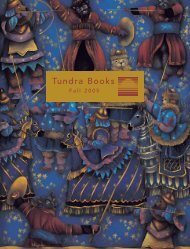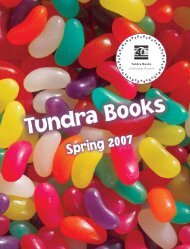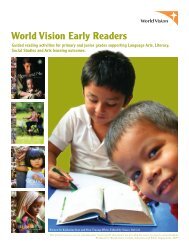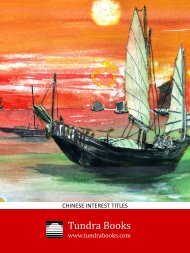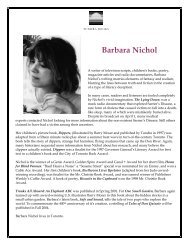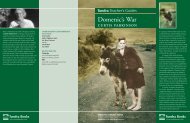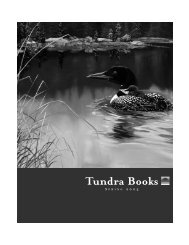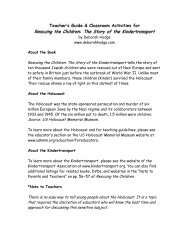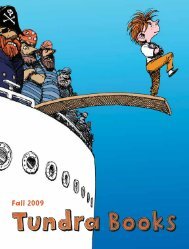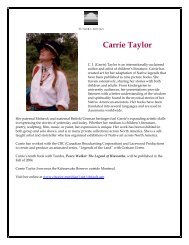In Spite of Killer Bees Julie Johnston - Tundra Books
In Spite of Killer Bees Julie Johnston - Tundra Books
In Spite of Killer Bees Julie Johnston - Tundra Books
Create successful ePaper yourself
Turn your PDF publications into a flip-book with our unique Google optimized e-Paper software.
<strong>In</strong> <strong>Spite</strong> <strong>of</strong> <strong>Killer</strong> <strong>Bees</strong><br />
<strong>Julie</strong> <strong>Johnston</strong><br />
A Teacher’s Guide<br />
by<br />
Ann da Mota and Sage Day<br />
Gordon A. Brown Middle School<br />
Toronto, Ontario<br />
April 2003<br />
A Teacher’s Guide for <strong>In</strong> <strong>Spite</strong> <strong>of</strong> <strong>Killer</strong> <strong>Bees</strong> © 2003 by Ann da Mota and Sage Day, Gordon A.<br />
Brown Middle School, Toronto, Ontario. All rights reserved.
Pre-reading Activities<br />
Discuss the following questions as a class:<br />
1) How would life change if you had to move from a fairly large urban area<br />
to a rural area? (social, economic, etc)<br />
2) Have you ever had to move? What feelings and apprehensions did you<br />
experience? Why?<br />
3) Did you ever anticipate receiving something valuable or that something in<br />
your life was going to turn out a certain way and it didn’t happen? Explain<br />
what happened.<br />
2
The questions in this novel study guide are based on Bloom’s Taxonomy which<br />
consists <strong>of</strong> six levels <strong>of</strong> questioning:<br />
1) Knowledge (lowest level)<br />
2) Comprehension<br />
3) Application<br />
4) Analysis<br />
5) Synthesis<br />
6) Evaluation(highest level)<br />
The teacher is encouraged to choose the activities which best suit the interests<br />
and needs <strong>of</strong> his/her students.<br />
A list <strong>of</strong> extensions, ministry expectations, and an appendix with support<br />
materials has been included for your reference and use.<br />
Ministry Expectations Addressed<br />
Grade 8<br />
* (refer to The Ontario Curriculum for Grade 8 Geography and Grade 8 Language)<br />
Economic systems(Geography)<br />
- demonstrate an awareness <strong>of</strong> the fundamental elements <strong>of</strong> an economic system:<br />
what goods are produced; how they are produced; for whom they are produced;<br />
and how they are distributed<br />
- describe the impact <strong>of</strong> a new industry on the economy <strong>of</strong> a region<br />
Migration (Geography)<br />
- identify factors that influence people to move to another place (e.g., plenty <strong>of</strong><br />
employment opportunities, security)<br />
- identify barriers to migration (e.g., physical, financial, legal, emotional)<br />
Patterns in Human Geography<br />
- demonstrate an understanding <strong>of</strong> employment patterns and trends<br />
3
Writing<br />
- communicate ideas and information for a variety <strong>of</strong> purposes and to specific<br />
audiences, using forms appropriate for their purpose and features appropriate to<br />
the form<br />
- produce pieces <strong>of</strong> writing using a variety <strong>of</strong> specific forms, techniques and<br />
resources appropriate to the form and purpose, and materials from other media<br />
- produce media texts using writing and materials from other media<br />
Reading<br />
- explain their interpretation <strong>of</strong> a written work, supporting it with evidence from<br />
the work and from their own knowledge and experience<br />
- understand the vocabulary and language structures appropriate for this grade<br />
level<br />
- make judgments and draw conclusions about ideas in written materials on the<br />
basis <strong>of</strong> evidence<br />
- clarify and broaden their own points <strong>of</strong> view by examining the ideas <strong>of</strong> others<br />
- plan a research project and carry out the research<br />
- identify some stylistic devices used in literary works (e.g., metaphor, simile) and<br />
explain their use<br />
Oral and Visual Communication<br />
- use tone <strong>of</strong> voice and body language to clarify meaning during conversations and<br />
presentations<br />
- identify and analyse the formulas used in different categories <strong>of</strong> media works<br />
- create media works <strong>of</strong> some technical complexity<br />
4
Vocabulary:<br />
<strong>In</strong> <strong>Spite</strong> <strong>of</strong> <strong>Killer</strong> <strong>Bees</strong><br />
<strong>Julie</strong> <strong>Johnston</strong><br />
panorama (pg. 1)<br />
flecked with diamonds (pg. 1)<br />
glancing sun (pg. 1)<br />
nestles (pg. 1)<br />
spire (pg. 1)<br />
ogling (pg. 2)<br />
homicide (pg. 2)<br />
chassis (pg. 4)<br />
beneficiaries (pg. 6)<br />
lolled (pg. 8)<br />
retching (pg. 12)<br />
Activities:<br />
Chapter 1<br />
1. Identify the characteristics <strong>of</strong> an effective exposition <strong>of</strong> a novel. (analyze re:<br />
elements <strong>of</strong> a novel and author’s style)<br />
Identify the characteristics <strong>of</strong> an effective “hook” (introductory sentence or<br />
paragraph).<br />
Evaluate the effectiveness <strong>of</strong> chapter 1 as an exposition.<br />
Evaluate the effectiveness <strong>of</strong> the first sentence (or paragraph) as a hook.<br />
2. Illustrate the village <strong>of</strong> Port Desire as seen by the girls for the first time.<br />
3. Explain the purpose <strong>of</strong> the blank lines in this chapter (and others to come).<br />
5
Chapter 2<br />
Vocabulary:<br />
tarpaulin (pg. 13)<br />
coherent (pg. 15)<br />
doleful (pg. 15)<br />
gangly (pg. 16)<br />
dregs (pg. 16)<br />
disgorged (pg. 17)<br />
resemblance (pg. 22)<br />
imposter (pg. 22)<br />
drone (pg. 22)<br />
artifact (pg. 23)<br />
amass (pg. 23)<br />
disjointed (pg. 30)<br />
Activities:<br />
1. Write a response to Chapter 2 using the format introduction,<br />
summary, reflection.<br />
2. Conduct a character analysis on each <strong>of</strong> the three sisters. Consider what is<br />
said about each, their appearance, and what they do, say, feel and think.<br />
3. Prepare a family tree for the Quades.<br />
6
Chapter 3<br />
Vocabulary:<br />
bloat (pg. 33)<br />
cringed (pg. 33)<br />
flustered (pg. 35)<br />
entreaties (pg. 37)<br />
forfeit (pg. 37)<br />
depleted (pg. 37)<br />
bequeathed (pg. 38)<br />
scrupulous (pg. 42)<br />
minuscule (pg. 45)<br />
sabbatical (pg. 47)<br />
stipulations (pg. 48)<br />
gander (pg. 48)<br />
aghast (pg. 49)<br />
Activities:<br />
1. Take turns to read aloud ensuring that you change voice for each character.<br />
2. What new information is there to help you better understand each sister?<br />
3. Imagine you are the editor <strong>of</strong> an advice column in the local newspaper or<br />
host an advice show on television or radio. Prepare a letter (or a script) from<br />
Aggie seeking advice and your response to her.<br />
7
Chapter 4<br />
Vocabulary:<br />
trespassers (pg. 52) lacquered (pg. 58)<br />
sweltering (pg. 53) construed (pg. 59)<br />
stricken (pg. 54) crestfallen (pg. 61)<br />
fetish (pg. 55) mausoleum (pg. 62)<br />
underevolved mutant (pg. 56) salting (pg. 69)<br />
shorn (pg. 56) hobnob (pg. 70)<br />
lopsided (pg. 58) preoccupation (pg. 70)<br />
Activities:<br />
1. Answer the following:<br />
a) How much time elapses in this chapter?<br />
b) Describe Aggie’s dilemmas in this chapter.<br />
c) Compare and contrast Aggie and Aunt Lily using the<br />
following headings: appearance, actions, speech, thoughts.<br />
d) Explain:<br />
(i) the use <strong>of</strong> italics in “We don’t have it. The estate has it.”<br />
(ii) the meaning <strong>of</strong> and significance <strong>of</strong> ergo and ergomaniac.<br />
(iii) the meaning <strong>of</strong> dappled shade.<br />
2. Use the decision-making model <strong>of</strong> your choice to select an ideal job for any<br />
one <strong>of</strong> the three sisters. (See chart provided in appendix)<br />
As this chosen sister, produce a curriculum vitae (resume) and cover letter<br />
applying for this ideal job.<br />
8
Chapter 5<br />
Vocabulary:<br />
comtemplates (pg. 73)<br />
snatches <strong>of</strong> tunes (pg. 73)<br />
writhing in agony (pg. 77)<br />
breadwinner (pg. 77)<br />
resigned (pg. 78)<br />
inevitable (pg. 80)<br />
Activities:<br />
1. List at least 5 examples <strong>of</strong> metaphors and similes and explain their meaning.<br />
2. Identify some <strong>of</strong> the barriers to migration (urban to rural) faced by the<br />
Quade sisters.<br />
3. Create a short mystery story about the little door in the wall<br />
behind the sink in the bathroom.<br />
9
Chapter 6<br />
Vocabulary:<br />
ambles (pg. 83) rally (pg. 89)<br />
camouflage (pg. 83) assailed (pg. 89)<br />
dicey (pg. 83) demolished (pg. 89)<br />
idiosyncrasies (pg. 85) serrated (pg. 90)<br />
splicing (pg. 86) felony (pg. 90)<br />
paltry (pg. 87) divvy (pg. 91)<br />
quizzically (pg. 89)<br />
pr<strong>of</strong>ound (pg. 89)<br />
Activities:<br />
1. “I have this irrational fear <strong>of</strong> you, and so naturally I will hate you until I find a<br />
substantial reason for doing so.” How well does this quote sum up the<br />
relationships in the novel. Justify your opinion.<br />
2. Compose a diary entry about Aggie’s first day at school,<br />
writing in role from one <strong>of</strong> the following perspectives:<br />
- Aggie<br />
- teacher or principal<br />
- fellow student e.g. Cameron, Rachel<br />
3. Examine how the appearance <strong>of</strong> bread affects the household.<br />
Predict what this holds for their future.<br />
10
Chapter 7<br />
Vocabulary:<br />
<strong>of</strong>ficial (pg. 92) intuition (pg. 100)<br />
straddling (pg. 93) apiary (pg. 105)<br />
stationary (pg.93) anencephalic (pg. 108)<br />
sullenly (pg. 93)<br />
loiters (pg.108)<br />
downcast (pg. 93) surly (pg. 108)<br />
wary (pg.93) perseverance (pg. 111)<br />
typecasting (pg. 94) lament (pg. 112)<br />
hackles (pg. 96)<br />
subterfuge (pg. 96)<br />
primping (pg. 98)<br />
Activities:<br />
1. The Quades are “a family <strong>of</strong> risk-takers”. Evaluate this<br />
statement.<br />
2. Analyze Aunt Lily’s character so far. Predict what decision she’ll make in the<br />
end and justify your opinion.<br />
3. List all the references to and different meanings <strong>of</strong> bread and<br />
explain the symbolism. You may wish to refer to previous<br />
chapters as well.<br />
4. Aggie believes the endpoint to the story is “so obvious”. Create Aggie’s<br />
conclusion to the film script taking into account her intention to “put bees<br />
into her movie”.<br />
11
Chapter 8<br />
Vocabulary:<br />
deciphering (pg. 113) accusingly (pg. 114)<br />
no dice (pg. 114) carnivore (pg. 115)<br />
notation (pg. 115) evenhanded (pg. 118)<br />
perplexed (pg. 117) lethal (pg. 119)<br />
garish (pg. 120) mark time (pg. 120)<br />
dignitary (pg. 120) wangle (pg. 122)<br />
hurdy gurdy (pg. 123) diplomacy (pg. 123)<br />
abreast (pg. 123) lavish (pg. 125)<br />
Activities:<br />
1. Compose a newspaper article about Aggie’s bee experience.<br />
2. Explain the significance <strong>of</strong> “When you look too closely at things, they<br />
become blurred”. (pg. 113)<br />
3. Predict how Aggie’s and her sisters’ lives might change in the<br />
absence <strong>of</strong> the “killer” bees and in light <strong>of</strong> her newly gained<br />
“confidence”.<br />
4. Find the references to and explain the symbolism <strong>of</strong>:<br />
- bread<br />
- water/lake<br />
- bees<br />
- movies<br />
in this chapter and previous chapters.<br />
12
Chapter 9<br />
Vocabulary:<br />
episode(pg. 128)<br />
windfall (pg. 128)<br />
potential (pg. 130)<br />
shuddery (pg. 131)<br />
eviscerated (pg. 132)<br />
giblets (pg. 132)<br />
skeptically (pg. 133)<br />
inspire (pg. 135)<br />
plaintive (pg. 135)<br />
unwholesome (pg. 136)<br />
indefinitely (pg. 136)<br />
meander (pg. 137)<br />
scholarship (pg. 138)<br />
squander (pg. 139)<br />
chronically (pg. 140)<br />
dollops (pg. 141)<br />
burrow (pg. 141)<br />
Activities:<br />
1. Read the introduction to Aggie’s letter on page 137.<br />
Compose the rest <strong>of</strong> Aggie’s letter to Aunt Lily trying to persuade her to<br />
move into the old Quade home.<br />
Consider the details outlined in the will and Aggie’s great need to keep the<br />
family together.<br />
2. Jeannie and Helen have received a number <strong>of</strong> rejections to their requests for<br />
work. With a partner, create a script for a job interview. Take turns role<br />
playing both the employer and the applicant. Describe how your<br />
conversation, attitude and behaviour changes in each role.<br />
13
Chapter 10<br />
Vocabulary:<br />
sluggish (pg. 142)<br />
scurry (pg. 143)<br />
grating (pg. 144)<br />
irrational (pg. 145)<br />
reluctantly (pg. 145)<br />
varnished (pg. 145)<br />
precariously (pg. 145)<br />
contemplating (pg. 147)<br />
blitzed (pg. 149)<br />
splicing (pg. 155)<br />
bewilderment (pg. 155)<br />
unadulterated (pg. 157)<br />
dejectedly (pg. 157)<br />
benevolently (pg. 157)<br />
Activities:<br />
1. State your hypothesis regarding the disappearance and<br />
reappearance <strong>of</strong> various items in the Quade household. Find<br />
evidence in the story to support your hypothesis.<br />
2 Use a dictionary to find the meaning <strong>of</strong> “entrepreneur”. Write the definition<br />
in your own words.<br />
Aggie, Jeannie and Helen have become entrepreneurs. List the sequence <strong>of</strong><br />
events that needed to occur before this could happen. (Begin with the events<br />
in Chapter 9)<br />
3. Compare the development <strong>of</strong> the girls’ new company with what<br />
happens in the ‘real world’ when someone wants to start a<br />
business. You will need to do some research on how to start a<br />
business.<br />
14
Chapter 11<br />
Vocabulary:<br />
temporary (pg. 160)<br />
fragile (pg. 160)<br />
politically incorrect (pg. 162)<br />
clientele (pg. 162)<br />
raft (pg. 162)<br />
venture (pg. 165)<br />
jostle (pg. 167)<br />
Activities:<br />
1. The role <strong>of</strong> director seems to become Aggie very well. Do you agree or<br />
disagree? Justify your answer.<br />
2. Predict why Aggie’s mother has come and what you think will<br />
happen now that she is here.<br />
3. Illustrate Aggie’s and Cameron’s semi-formal costumes based on the<br />
descriptions provided in this chapter.<br />
15
Chapter 12<br />
Vocabulary:<br />
defensively (pg. 172)<br />
lap <strong>of</strong> luxury (pg. 172)<br />
skeptically (pg. 174)<br />
cast-<strong>of</strong>f (pg. 178)<br />
adjustment (pg. 180)<br />
splicing(pg.182)<br />
confront (pg. 186)<br />
psychiatric ward (pg. 188)<br />
Activities:<br />
1. Compose a monologue (conversation between an actor and the audience)<br />
from the perspective <strong>of</strong> Aggie, Jeannie, OR Helen regarding the arrival <strong>of</strong><br />
their mother. Present it to the class.<br />
2. Discuss the significance to the story <strong>of</strong> the following excerpt on page 137:<br />
There isn’t a sound, yet it feels like war. Three people<br />
have icy looks on their faces, and Aggie’s heart is flopping<br />
around like a scared bird.<br />
3. Use the graphic organizer provided to do a character analysis <strong>of</strong> Candy.<br />
4. How would you rate Candy as a parent and as a fellow human being? Justify<br />
your answer.<br />
16
Chapter 13<br />
Vocabulary:<br />
premiere (pg. 190)<br />
radiate glory (pg. 190)<br />
technician (pg. 191)<br />
ionic (pg. 192)<br />
flick (pg. 197)<br />
exasperated (pg. 199)<br />
Spanish <strong>In</strong>quisition (pg. 200)<br />
prompted (pg. 201)<br />
mourning (pg. 203)<br />
tousled (pg. 203)<br />
sanctuary (pg. 203)<br />
Activities:<br />
1. Use the information provided in this chapter to draw your own conclusion<br />
about what happened to the money.<br />
2. After Aggie is interrogated about the missing money, she says: “Do you<br />
know what this is like? This is actually like killer bees!” (page 203) <strong>In</strong>fer what<br />
Aggie means by this statement.<br />
3. Identify Aggie’s main allies. Support your choices with evidence from the<br />
story.<br />
17
Chapter 14<br />
Vocabulary:<br />
unleashed (pg. 206)<br />
futile (pg. 207)<br />
cynical (pg. 208)<br />
embedded (pg. 210)<br />
depraved (pg. 217)<br />
froths (pg. 217)<br />
Activities:<br />
1. Why do you think people would automatically assume Aggie stole the<br />
money? Explain your thinking.<br />
2. Duncan says that “More people confess their crimes before Christmas than<br />
any other time during the year.” Why do you think that is the case? Discuss<br />
your response with the class.<br />
3. Identify the possible suspects for stealing the money from Aggie’s school<br />
play. Create an argument to support either the guilt or innocence <strong>of</strong> ONE <strong>of</strong><br />
the suspects.<br />
18
Chapter 15<br />
Vocabulary:<br />
pool all their earnings (pg. 221)<br />
kleptomaniac pg. 222)<br />
paralyzed (pg. 223)<br />
abandoned (pg. 224)<br />
resuscitation (pg. 225)<br />
consumed with guilt (pg. 227)<br />
decipher (pg. 228)<br />
disconsolate (pg. 229)<br />
obscure (pg. 232)<br />
akimbo (pg. 233)<br />
Activities:<br />
1. <strong>In</strong> this chapter, no one is sure whether or not Jeannie will survive her<br />
experience falling through the ice into the lake.<br />
Have you ever had an experience where you had no control over the<br />
outcome? Write a brief summary <strong>of</strong> your experience and how you dealt with<br />
it. What advice would you give to Aggie, Helen, and the others?<br />
2. Explain the significance <strong>of</strong> Aggie’s tears after she reads her mother’s letter.<br />
3. <strong>In</strong> what ways are Aggie and her mother very much alike?<br />
4. What did Aunt Lily learn from her brother’s mistakes?<br />
19
Chapter 16<br />
Vocabulary:<br />
diminished (pg. 236)<br />
affirmative (pg. 237)<br />
multitudes (pg. 240)<br />
psychotic (pg. 242)<br />
short-circuit (pg. 244)<br />
paraphernalia (pg. 249<br />
regaling (pg. 250)<br />
enigmatically (pg. 251)<br />
wistfully (pg. 252)<br />
Activities:<br />
1. How has the reuniting <strong>of</strong> the family affected Aggie?<br />
2. Using a T-table for each character, compare and contrast the changes that<br />
occured in Aggie, Helen, Jeannie and Aunt Lily from the beginning <strong>of</strong> the<br />
book to this point.<br />
3. Aggie puts a great deal <strong>of</strong> thought into each gift she buys for her family.<br />
Discuss the meaning behind each one.<br />
20
Extensions<br />
1. For each chapter, list 3 - 5 new words and add to a class list.<br />
2. Analyze the author’s use <strong>of</strong> the present tense throughout the novel.<br />
3. Prepare a W5H (who, what, when, where, why, how) for any<br />
chapter.<br />
4. Find and explain the meaning <strong>of</strong> at least 10 different<br />
proverbs/sayings in the novel. Compile a class book <strong>of</strong><br />
proverbs based on the novel.<br />
5. Dramatize any scene <strong>of</strong> choice<br />
e.g. ch. 7 - the dispute between Aggie and Cameron<br />
ch. 5 - the fight between the sisters any <strong>of</strong> Aunt Lily’s visits<br />
- the conversation between Aggie and her teacher<br />
6. Discuss all the references to fantasy/fairy tales in the novel and explain the<br />
significance.<br />
7. Research and present a cottage industry <strong>of</strong> choice e.g.,<br />
pickling, knitting or any other examples at the fair in chapter 8.<br />
8. Compile a fashion portfolio showing at least 10 different<br />
outfits from the novel. Present your portfolio in an interesting<br />
manner e.g., catwalk <strong>of</strong> paper dolls.<br />
9. Identify some employment and workplace issues in Port Desire and describe<br />
their impact on the local workforce. Discuss.<br />
10. Write either a prologue (e.g., the girls’ lives as young children) or an epilogue<br />
to the novel.<br />
11. Create a short film or radio version <strong>of</strong> any <strong>of</strong> the “mysteries” in the novel.<br />
Present it to your class. List the elements that make this aspect <strong>of</strong> the story a<br />
mystery.<br />
21
12. Create a storyboard <strong>of</strong> key events in the story with captions under each<br />
event.<br />
13. Read Little Women by Louisa May Alcott. Compare and contrast the girls in<br />
the story to Helen, Jeannie, and Aggie.<br />
22




